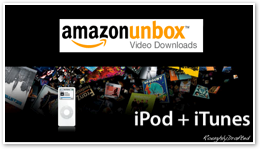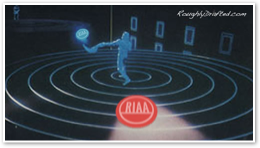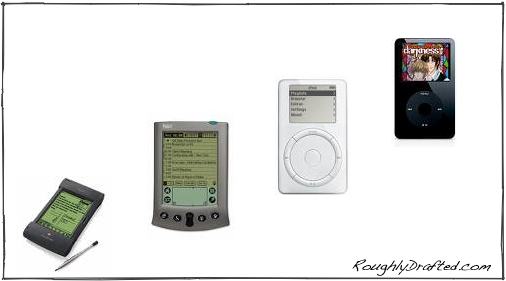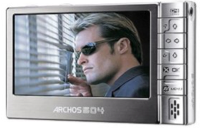
iPod, iPhone, iTV: Why Apple's New Platform Works
Apple's strategy for a new set of consumer electronics devices seems to be beyond the grasp of most industry analysts. That should really come as no surprise, because they don't seem to understand what made the iPod a success over the last five years either.
Since its release, analysts have been falling all over themselves to identify the next “iPod killer.” They still throw out the phrase every time Sony releases a new version of a Walkman branded phone or Microsoft renames its latest version of Janus DRM, to suggest that the iPod is on the verge of being eclipsed.
In reality however, the iPod is not only experiencing dramatic growth, but also moving into new markets and new form factors. Not only are there three lines of iPods, but there are at least two more iPod cousins on the way: the already announced iTV device, and the rumored iPhone.
An iPhone By Any Other Name
News analysts seem to think that the only thing clever about Apple's emerging platform is the "i" name. Recently, the announcement of VoIP products from Cisco's Linksys brand overwhelmed the headlines because it launched products under the "iPhone" name that is used when referring to rumors of Apple's new mobile.
Of course, Apple hasn't advertised the iPhone name, nor has it even officially recognized that it is building a mobile phone. In any event, the success of its venture into mobile phones does not hinge on the name or being first to market; "iPod" was an unlikely name for a runaway success five years ago, and similar devices were already on sale.

This also sounds an awful lot like Amazon's Unbox, the movie store that was unleashed ahead of Apple's. Unbox was swarmed in news babble, then ultimately forgotten as a poor service offering.
Apple simply dropped the M from iTMS, and added higher quality movie downloads and iPod games. It wasn't a new venture into the unknown, but rather an obvious extension of Apple's existing business. Apple now has 90% of the movie download business.
Remember too that the other iPod cousin is only tentatively named iTV, a name Steve Jobs described as a temporary placeholder. Clearly, a catchy name isn't what's carrying sales of the iPod, and won't be what makes or breaks the iTV and iPhone.
Why the iPod Works
The iPod isn't the most revolutionary music device on the planet in terms of technology. There are rival players that use removable media like the Sansa, there have been wireless sharing devices like the MusicGremlin, and a variety of devices that are designed to play--and even record--movies on larger screens, like those from Archos.
Why are these competing devices, with new and different features, not matching the iPod's success? Because they fail to hit 80% of the needs of the market.
They don't match the simplicity of the iPod and then add new features. Instead, the highest end devices seek to overload functionality in a way that only makes it available to a minority of the market: those who like to play with gadgets.
Good Enough
The iPod doesn't really offer a lot of gadget interest, apart from offering a slick looking interface inside a tightly engineered package. More than anything else, the iPod is just plain functional. It plays music. Because it does its core job so well, it can be put to use to do other things where it isn't the absolute best, but is good enough.
For example, the full size iPod makes a good enough portable movie player. Fill it with ripped DVDs, podcasts, and home movies, then plug the tiny handheld to any TV for good quality playback. No effort, no configuration, one simple cable. There are devices that offer higher quality playback or a larger built-in screen, but they are also more complex, offer less battery life, and don't work as a simple music player.
The lesson of being "good enough" was learned by Apple in the Newton years. That device intended to usher in a new platform, but didn't succeed because the original MessagePad cost too much and didn't offer enough value for consumers. It lacked a killer application, and instead tried to do everything well. In order to be ready to "do everything," it had to be too big, and run too slow. 

Selling Simple
By 1997, the $700-1000 Newton was eclipsed by the $300 Palm Pilot. The Palm didn't attempt to match the Newton's functionality or capacity, but rather tried to do simple organization tasks well. At a time when mobile phones did nothing but place calls, the Palm Pilot filled a gadget niche while also serving as a useful tool.
By 1999, everyone who needed a gadget had a Palm. The apex of Palm development was the razor-thin Palm V, which offered a high quality monochrome screen, days of battery life, and was the model of simplicity. I brought one on a month long vacation, only stopping to charge it once half way through. I relied on it to make notes, plan events, and look up numbers; it was frequently a lifesaver.
Losing Focus
Palm eventually ran out of ideas, and its device struggled for a reason to remain relevant as mobile phones began to offer the same features. Jeff Hawkins, the brain behind the Palm, left for Handspring to begin work on a new device that could also act as a mobile phone, resulting in the Handspring Treo.
Back at Palm however, the company lost track of what originally made the Palm useful, and instead chased after Microsoft's goals for WinCE devices: feature laden boxes with fast processors, far more memory, and bright color screens.
All that "potential" made WinCE devices practically useless: abysmal battery life, and since its software is built with no regard for limited resources, it is both slow and unstable. The fancier the WinCE hardware got, the less functional it became.
Sure enough, when Palm followed the same strategy it wound up with the same result: new Palms needed to be recharged every day and were increasingly less competitive with mobile phones, which offered many of the same features. Both Palm and Microsoft seemed desperate to prove itself as the least competent in a battle of handheld half-wits.
Enter the iPod
As Palm fell into the throes of death, Microsoft declared victory for WinCE as a new monopoly in handheld computing. The media was so excited about WinCE being the new Palm that nobody stopped to ask if being Palm even mattered anymore. 

PDAs were dying. Instead of a new PDA, Apple introduced the iPod in 2001. Digital music had also been in a terminal coma throughout the 90s; Apple paired the two failures to make a successful product.
Like the Palm, the iPod had some organizer functions. But the real difference was that it could play music--lots of music--thanks to its build in hard drive.
Unlike either the Palm or WinCE boxes, the iPod was mainly a hard drive. It ran a simple embedded operating system and was tuned primarily to play back music, not do everything.
It took years for the success of the iPod to sink in; the first reaction in the press was to ask Microsoft how it would copy the iPod and bring it to the world. Microsoft answered with Janus, an a new mobile DRM system that would tie every song played to Microsoft technologies and royalty fees. Later renamed PlaysForSure, the technology was promised by 2003 but didn't actually arrive until 2004.
Microsoft's inability to ship allowed Apple time to not only sell millions of iPods and establish the brand, but also to develop an alternative to abusive DRM. Steve Jobs convinced music labels to sell content online using FairPlay, a DRM system that Mac iPod users could use as an option, and easily defeat by burning to CD.
Rather than clamping down music in an impossible effort prevent all theft, Jobs suggested that the labels profit by providing honest customers a superior product to buy.
Why iPod is Winning
After two winters of PlaysForSure failure in 2004 and 2005, Microsoft decided that its Janus technology wasn't the source of the problem, but rather it was all due to the incompetence of its parters such as Yahoo! and Napster.
It rebranded the system under a new name and promptly rolled out the resulting Zune as the most spectacular failure of 2006. Oh the Humanity!
In the same time period, Apple created a new iPod Mini line of smaller hard drive players to take on the flash market, then introduced the Shuffle and Nano as new flash based iPod players.
All of these products quickly outsold competitors. Was Apple's success all an illusion, or vendor lock in, or an abusive monopoly?
The iPod's success is a combination of a lot of elements: effective marketing, a simple and easy to use product, retail availability, and just plain good business. Those are the factors that will enable Apple the opportunity to continue to broaden its iPod success into other product categories.
Competitors have a few elements in place, but nobody has anything approaching an equal product lineup, matched with sales momentum and an installed base, and an established service back end for media and software sales.
Apple has a integrated network effect in place, and each node it adds to its network simply makes the entire system more useful. The next article will examine this network and show how services and products all fit together in an integrated strategy.
Next Article:
This Series










Thursday, December 21, 2006



 Bookmark on Del.icio.us
Bookmark on Del.icio.us Discuss on Reddit
Discuss on Reddit Critically review on NewsTrust
Critically review on NewsTrust Forward to Friends
Forward to Friends
 Get RSS Feed
Get RSS Feed Download RSS Widget
Download RSS Widget





